Twitter and Zapotec Language Activism
Eloise Kadlecek and Collin Kawan-Hemler
This chapter is an introduction to the networks of Twitter users and hashtags that Zapotec people use in coordination with the Ticha Project. A Twitter account is not required but is recommended for those who wish to participate in these digital networks. We will walk you through how to use Twitter as well. To better understand why Zapotec people use Twitter as an area of language activism, you can check out the module on Language Shift.
Resources in this module: Teaching Summary · Answer Key · Spanish Version
1. Accessibility of social media
Social media is one tool that Zapotec speakers use to create digital spaces that promote Indigenous language use. Speakers share Zapotec cultural and linguistic knowledge to larger audiences. Through the Ticha Project, one of our hopes is to make information about the Zapotec language more accessible for members (and non members) of the Zapotec community. Social media has been a tool utilized in this process; it is an easy way to share vocabulary, writing, and thoughts about Zapotec language quickly, and it can be viewed by virtually anybody.
Questions to think about before starting this chapter
- What is language activism?
- How can social media be used to promote language activism?
- Where have you seen Indigenous language activism happen, on and offline?
- If you speak an Indigenous language or are trying to learn, where would you like to see that language represented, used, or written?
- What are some possibilities for the future in terms of Indigenous language representation? How else can Indigenous language be encouraged and amplified? Come up with ideas and share them with a peer.
2. What is Zapotec Twitter?
Twitter is one of the most active platforms for Zapotec language social media. Many accounts tweet in Zapotec and share pictures and videos about their daily lives. A number of forms of Zapotec language activism can be accessed when you look on Twitter! Below are some examples of some of the content you can find.
Celebrating activism and collaboration, thanks a lot CPGC ! // Celebrando activismo y colaboración, gracias CPGC ! // Xtioste’n CPGC te de mazhcuel ne de mi’ny racne don cut ditx xtenu… #UsaTuVoz #ZapotecoColonial pic.twitter.com/YKlX4u0ERP
— Moisés García Guzmán (@BnZunni) October 29, 2020
Ejercicio con Pronombre:
Zapoteco del Valle de TlacolulaLiu rcuzhu clarinet lo bhius
Tu tocas el clarinete en la fiesta #Usatuvoz @DizhSa #felizdiadelmusico pic.twitter.com/RIqUo1rLo7— LUIS GUSTAVO CRUZ CRUZ (@LUISGUS23444569) November 22, 2020
Gueta dxa' #UsaTuVoz #ZapotecoColonial pic.twitter.com/k1pD6bvKbW
— Yaneth Molina (@YanethMolina99) February 6, 2019
Rulaba xduurasa te guintxeya te lady gitx. Na binizia le’n duu, lo traly, kon dyap les niaa, na binizia galay dixza, galay dixtily. #UsaTuVoz #ZapotecoColonial #zapoteco2020 pic.twitter.com/nqnLkCkfom
— Janet (@JanChvzSanti) October 28, 2020
Guxiny. Xtxa beu.
Konu. Ketyru.
Ruuna. Ruxhiza.
Ruuna stuy.
Nall. Bii.
Aza’
Gal rienla’z. #nostalgia #zapoteco #usatuvoz #todaslenguas pic.twitter.com/imDSA7Dbht— Janet (@JanChvzSanti) November 22, 2020
Uno: tób
Dos: chop
Tres: son
Cuatro: tap
Cinco: ga'y
zapoteco de San Bartolo Yautepec— Adela pata de perro (@correconejito) January 9, 2020
This selection of tweets are from users @YanethMolina, @JanChvzSanti, @BnZunni, @correconejito, and @LUISGUS23444569. They, among many other people, tweet in their variety of Zapotec and share photos from their lives.
One of the “hashtags” that each tweet uses is #UsaTuVoz (Use Your Voice). This hashtag was created by the Voces del Valle (Voices of the Valley) project in order to promote and amplify Indigenous language use, particularly in Oaxaca, Mexico. Since its creation, Oaxacan high school students have been encouraged to tweet in their Indigenous languages under the hashtag. The idea is to create a community of Indigenous language writers, learners, and activists on Twitter that can include multigenerational and transnational users. For younger folks of Zapotec heritage, both in Mexico and the United States, Zapotec-language tweets may be the first time that they see their language written and shared globally. Microblogging on a platform like Twitter resists language shift and challenges racist ideas that Zapotec and other Indigenous languages are “ancient”.
Hashtags like #UsaTuVoz, #ZapotecoColonial, and #EstudiosZapotecos were intentionally created to foster a multilingual digital space that supports Indigenous language use. This chapter will introduce you to a digital network with which the Ticha Project has established relationships. Those who use these hashtags invite non-Zapotec users to see parts of Zapotec communities that they might not be able to see otherwise. They are also open to direct participation by outsiders who retweet or try to learn/write Zapotec.
However, there is no singular “Zapotec Twitter”. It is important to act respectfully and to not intrude in conversations or spaces that are meant for community members only. Not all Zapotec language/heritage users on Twitter wish to participate with projects like Ticha that include non-Zapotec individuals and networks. One option on how to amplify the voices of Zapotec Twitter users is by retweeting or sharing tweets to your followers. Another option is messaging someone whose content you value to start a conversation about how you can participate and engage respectfully with Zapotec Twitter. One user that encourages and welcomes outsider participation is Felipe H. Lopez (@DizhSa), who is part of Ticha’s team. He tweets in Zapotec and is delighted when people engage with his content, even if they are not part of a Zapotec community. Other Zapotec Twitter users who welcome outsider interaction include Yaneth Molina (@YanethMolina99) and Moisés García Guzmán (@BnZunni).[1] Not every Zapotec content creator will have this same opinion, and there might be some aspects of sharing their language on social media that they wish to keep within Zapotec communities. The hashtags #UsaTuVoz, #ZapotecoColonial, and #EstudiosZapotecos are open to outsider engagement and interaction.
3. Using Twitter
To engage with Zapotec Twitter, it is helpful to know where to look and how to find tweets. Fortunately, Twitter has an advanced search tool that you can use to search through a hashtag. To access this screen type anything in the search bar (for example, “zapotec” and then click on “Advanced search” on the right side under “Search Filters.”
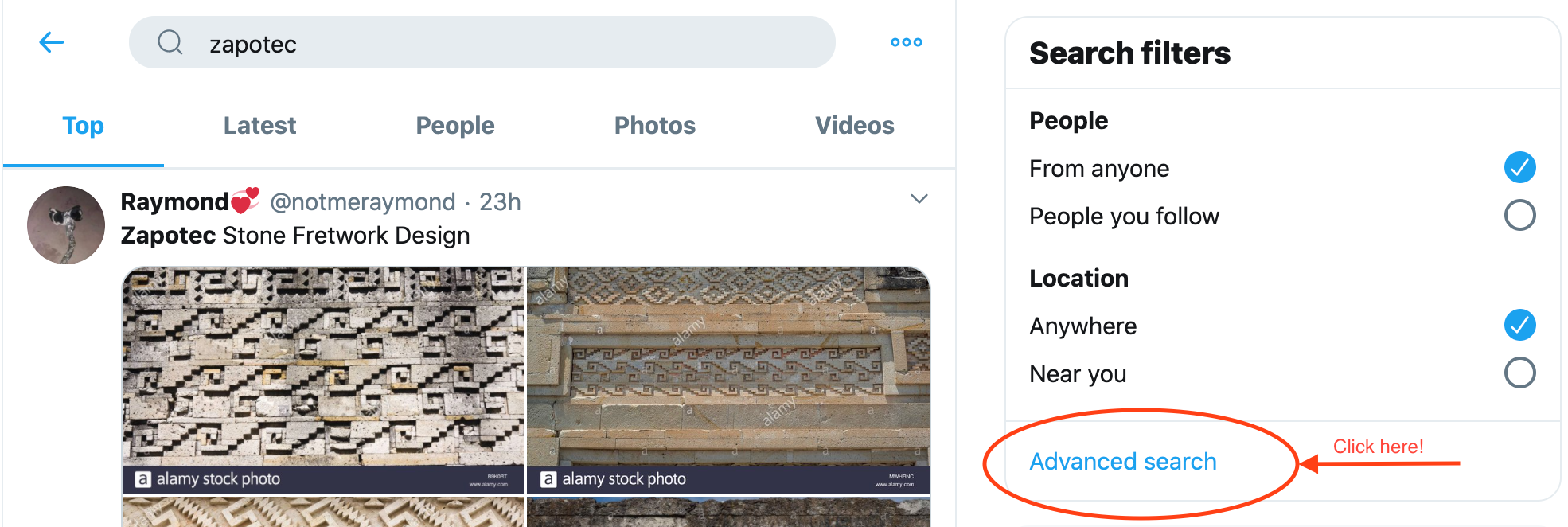
When a tweet includes hashtags or words/phrases preceded by a “#” symbol, it is marked as belonging to a particular topic. Someone who is interested in Zapotec Twitter can search under hashtags like #UsaTuVoz or #EstudiosZapotecos in order to find what they are looking for. These hashtags can unite the tweets of many people, who may not even know or follow each other, into a common digital space. Accounts like @TichaProject and @VocesValle act as collections of Zapotec written/visual/video media that we can search through. By using the advanced search features, we can narrow our focus in several helpful ways. For example, all the tweets or retweets from @VocesValle that has the hashtag #UsaTuVoz can be viewed and retrieved. We can even request tweets from specific periods of time like March 2019 to January 2020.
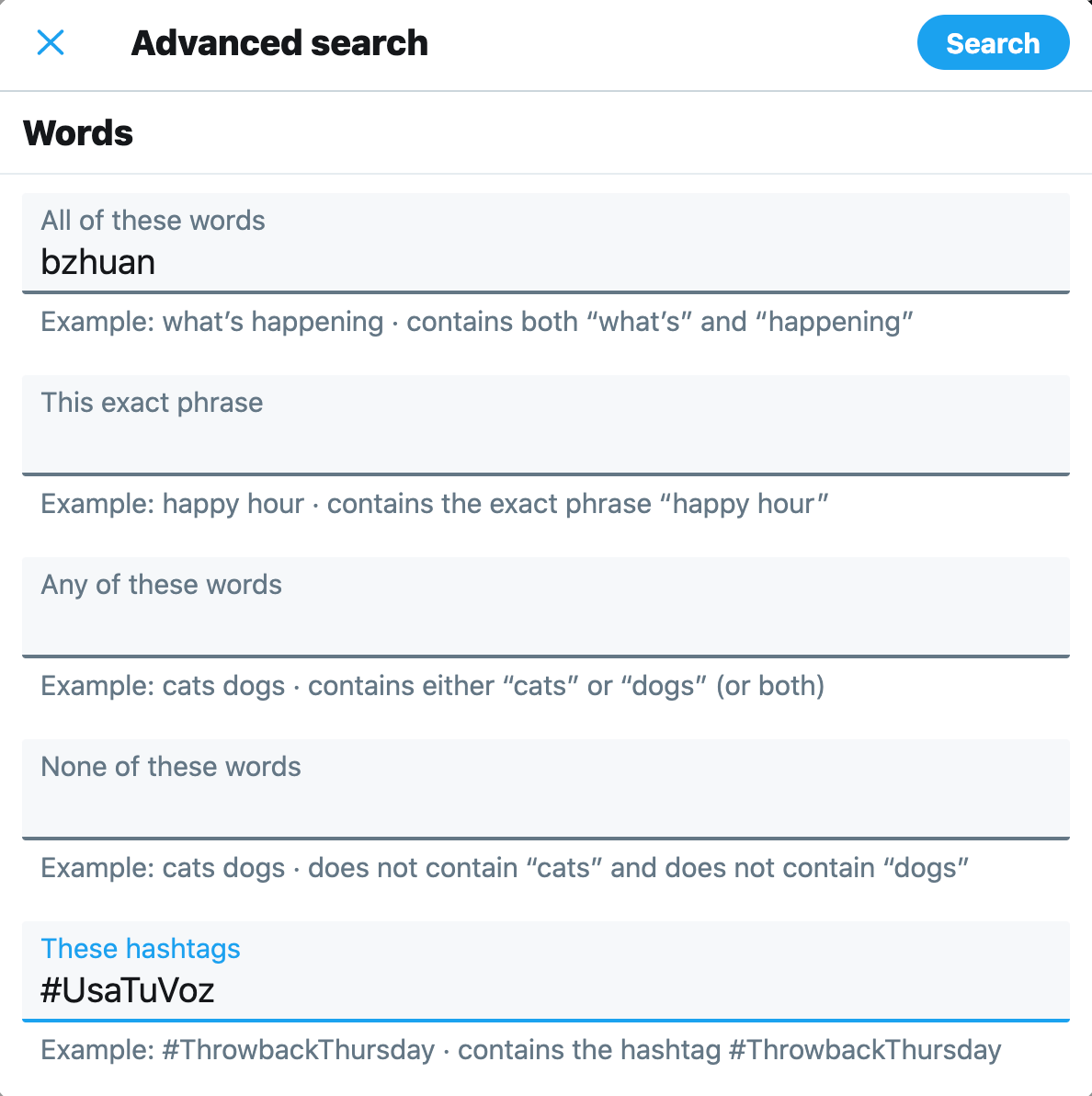
The above figure offers a sample search that you can try for yourself. Type “bzhuan” under the “All of these words” field and “#UsaTuVoz” under the “These hashtags” field. With this input, Twitter will output all of the tweets that contain both the word “bzhuan” and the hashtag “#UsaTuVoz.”
Bzhuan lo escribían Bexuana y significaba señor en Tlacochahuaya 1675 y beJuana en San Pero el Alto 1684 en Cordova de 1578 Pejuana Hoy su sentido religioso de ha perdido en varios pueblos el Valle de Tlacolula su significado es dueño de un animal #UsaTuVoz #ZapotecoColonial https://t.co/AhnV2vtYRZ pic.twitter.com/dieyaYZHzG
— bunyza (@DizhSa) July 10, 2020
Congratulations! You’ve found an amazing example of the type of knowledge-sharing that can happen on Zapotec Twitter. @BnZunni decided to tweet about the word Bzhuan which he learned about from the Conversatorios which members of the Ticha team facilitated with groups of interested people of Zapotec heritage in Oaxaca, Mexico, and in . Both @BnZunni and @DizhSa share the different meanings and spellings of bzhuan in different pueblos throughout time, giving us a sense of the diversity contained within Zapotec and the changes and continuities that present day speakers and writers have with those in the colonial period. They also supplement their tweets with images from the church of Tlacochahuaya and colonial era documents. We can appreciate the ways in which multimedia is utilized to share information on a platform like Twitter.
There are several ways for users to interact with tweets that can help Zapotec language, history, and culture content reach greater audiences. You can “like”, “retweet”, and “reply” to an original post. Notice how @DizhSa retweeted @BnZunni‘s original tweet, adding his own commentary and information. When you retweet someone else’s tweet, you allow content that usually would only be seen by the original user’s followers to be seen by your followers as well. The example in the figure above is not only reaching @BnZunni‘s followers but possibly all of @DizhSa‘s followers as well.
http://twitter.com/jvsmine1224/status/1329817071266394114?s=20
Twitter also provides a platform for Zapotec users to share their works of art or writing. Jasmine (@jvsmine1224) is proud to share her blog that connects her participation in the Conversatorios with the broader Oaxacalifornia community.
Add yourself to these already existing networks of Zapotec tweeters by following an account that interests you. You can observe the conversations going on and share moments of learning and exchange with your friends and family.
Exercise 1: Searching through Zapotec Twitter
Start by viewing Ticha’s Twitter account (@TichaProject) and other Zapotec language related accounts like @VocesValle to and check out accounts that they retweet. Take note of the types of content you see.
Using the advanced search tools, search through hashtags used among Zapotec and Oaxacan users on Twitter. Some hashtags include:
#Zapotec, #Oaxaca, #UsaTuVoz, #ZapotecoColonial, #EstudiosZapotecos, #Tlacochahuaya, (or other place names in Oaxaca)
Choose your favorite post and present it to a classmate! What languages and images are included in the tweet? Is the Twitter user in conversation with other accounts?
Exercise 2: How does it work in your language?
Most of the tweets that you’ll find through Ticha’s networks are in varieties of Valley Zapotec. Compare the tweets that you find and compare them with your varieties of Zapotec that you, your family, or community speaks. Which words do you have in common? What differences can you find?
4. Why do we tweet?
Now let’s hear from the people behind the Twitter accounts. We asked two members of different Zapotec communities, Moise´s García Guzmán (@BnZunni) and Felipe H. Lopez (@DizhSa), to share their thoughts about using social media to share information about Zapotec language and culture.
Moisés:
Moise´s García Guzmán is from San Jero´nimo Tlacochahuaya, Oaxaca, and he is a native speaker of Valley Zapotec. He is a Zapotec language activist who focuses on language and cultural preservation in Oaxaca.
Q: Why do you tweet in Zapotec?
A: To preserve my language and pass on all the knowledge we discover. Also to show that languages are dynamic and adaptable to the circumstances, taking advantage of the spaces social media offer.
Q: What does tweeting in Zapotec mean to you?
A: It means that my language is still present and that I want to show and share the visions we have. Every language has an interpretation of the world and everyday life, I want to show others how we see it and engage in a conversation about that, learning from others as well.
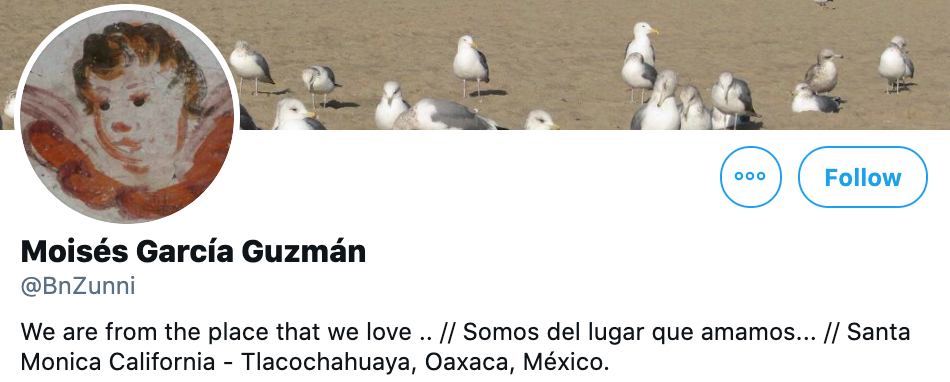
Felipe:
Felipe H. Lopez is originally from San Lucas Quaviní, Oaxaca, and his first language was San Lucas Quiaviní Zapotec, which is a variety of Valley Zapotec.
Q: Why do you tweet in Zapotec?
A: I tweet in Zapotec in order to let the users of Twitter know about my language. Many people say or write about Zapotec and other indigenous languages as being part of the past, so for me, it is also a way to tell them that Zapotec is not an ancient language. Zapotec languages are living languages that continue to be spoken by hundreds of thousands of people both in Oaxaca, Mexico as well as in the United States. I find that sharinfg my tweets is an easy way to get to other people who use Twitter, otherwise that would be hard to do. Now, since I began tweeting, I have received more and more interaction with other Zapotec writers and speakers as well as other indigenous people from Latin America. So, I think that I chose the right platform and the time I spend tweeting is well worth it.
Q: What does tweeting in Zapotec mean to you?
A: Tweeting in Zapotec is very special for me because, when I tweet in Zapotec it reflects the way I think and see the world. I tweet about issues and concepts that are relevant to my culture and identity, among other things. I feel that my tweets give us our own voice that for centuries has been denied to us. In Mexico, for instance, there are no public spaces that we can use for our voices to be heard. The educational institution, for example, was historically used to punish those who dare to speak an indigenous language in school. So, I find Twitter to be an easy space to use, with no restrictions, except the number of characters, and I convey issues that matter to me.
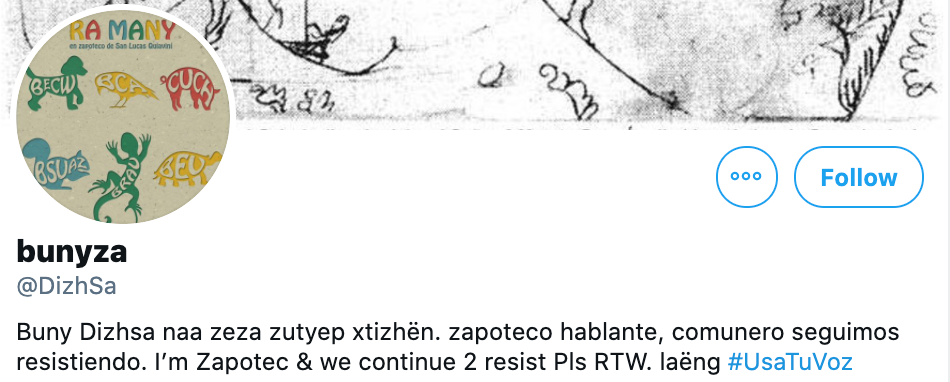
Exercise 3: What types of Indigenous knowledge are communicated in their Twitter feeds?
Take a few minutes to look through both Felipe and Moise´s‘s accounts. Observe and note what types of Indigenous knowledge that they share and display. What common themes exist between their language activisms? Why might they share different content?
Additionally, pay attention to the multilingual space that accounts invested in Zapotec language revitalization create. Why might Spanish and English be used alongside Zapotec?
5. Involving yourself in Zapotec language activism
An important point to consider while doing these activities is that while many Zapotec speakers are more than happy to include non-Zapotecs in the conversation of language preservation on social media, it’s always best to research and ask members of the Zapotec communities before posting anything that contains information about Zapotec language and culture. As explained in Section 1, participation by outsiders through the online networks that Ticha supports is welcome.
Exercise 4: Create your own “Zapotec word of the day” post
Using the Colonial Valley Zapotec dictionary on the Ticha website, choose a word to make a “post” about. You can illustrate this on a piece of paper and present it to a classmate as if it were on a social media platform, or make a digital one. Be creative! You can also look at the Ticha twitter account for inspiration. Be sure to the tag Ticha Project (@TichaProject) and use #ZapotecoColonial to connect to others.
To get some inspiration for this activity, below is a post a student research assistant made for a word in Colonial Valley Zapotec.
Palabra zapoteca del día: rago (comer)
Escucha la forma de hoy en Tlacochahuaya Zapotec: gal ro
Para ver más palabras de zapoteco colonial: https://t.co/5LkF1g5QGC
Imagen de: https://t.co/aqPWT5gqgZ
Audio de: https://t.co/PuJXXnIp2q
Hablante: Moisés García Guzmán pic.twitter.com/Lo1tjE0pPm— Ticha Project (@TichaProject) October 12, 2020
Exercise 5: Help transcribe colonial era documents
If you have patience and a careful eye, you can help Ticha transcribe the many handwritten Colonial Zapotec documents that have been digitized. These manuscripts have been incredibly useful in sharing Zapotec history, language and culture with students of all ages. However, reading early modern handwriting is difficult. That’s why transcription or typed representations of the manuscripts are so important. But 63 documents still have no transcription!
Refer to the introductory module on Ticha which gives an introduction to navigating the digital archive. Go to the “Texts” page of the Ticha website and sort “Transcription Status” by “None” in order to find a manuscript that you can begin transcribing.
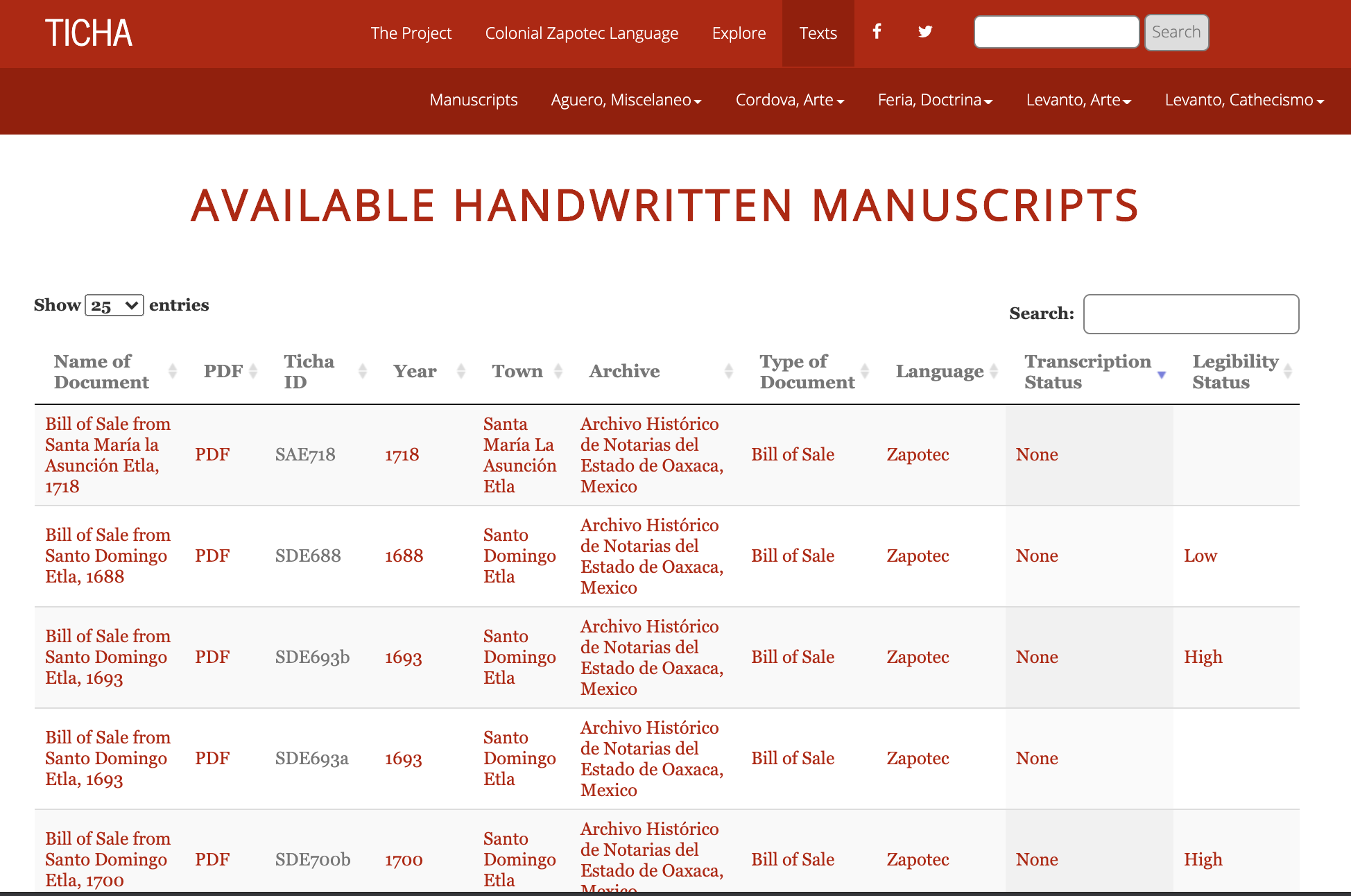
Once you select a document, click on “Transcribe” and follow the instructions provided. You can also check out the many transcription that are already available for reference.
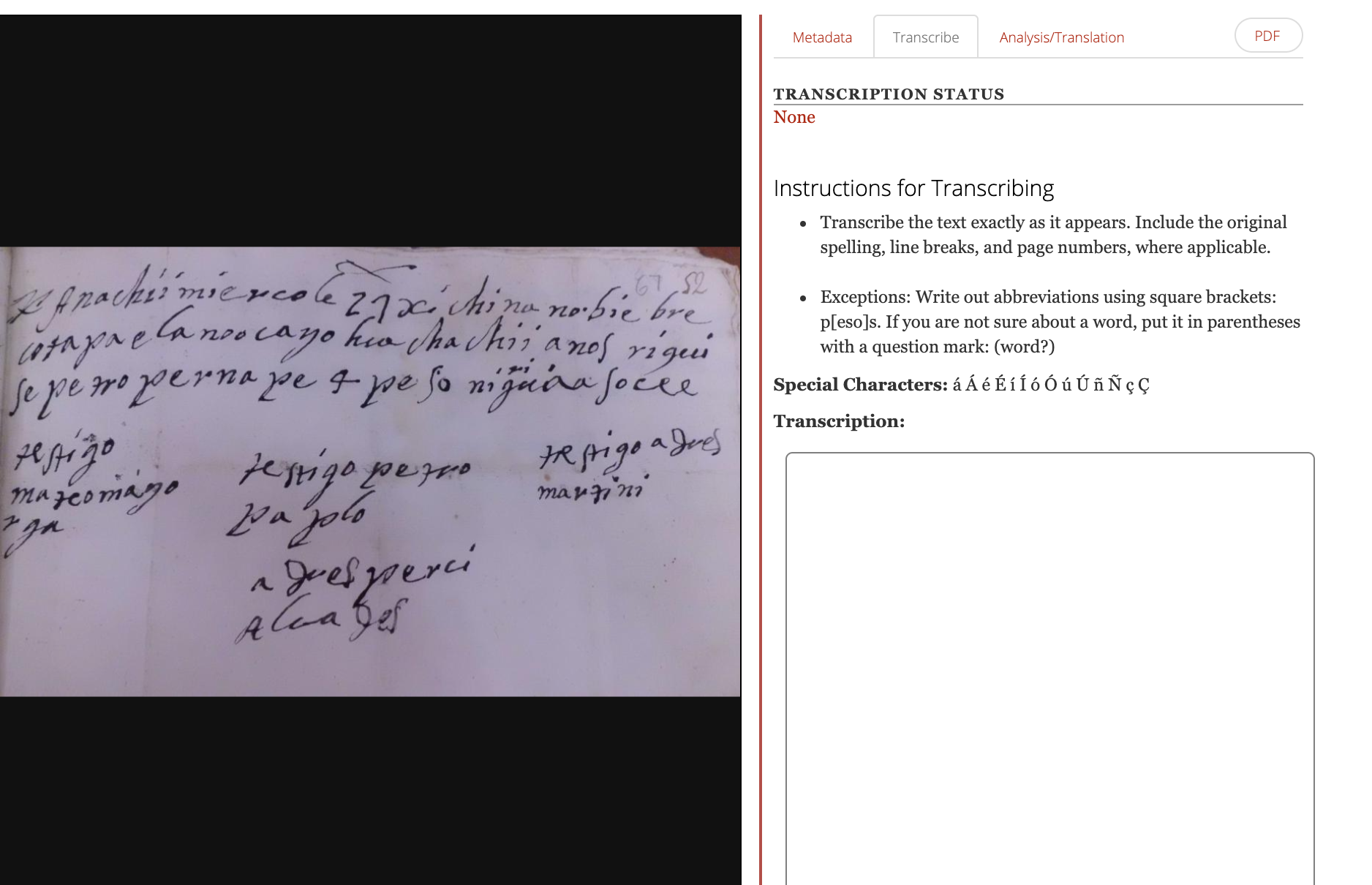
If you do complete a transcription, tweet about it and tag the Ticha Project (@TichaProject) and include one of the hashtags that we introduced in the chapter.
Exercise 6: Take a look at other Social Media platforms!
Aside from Twitter, platforms like Facebook, Instagram, and TikTok are also used by members of the Zapotec community to share knowledge.
A great way to find Zapotec content is to search hashtags such as #Zapoteco, #ZapotecoColonial, #Oaxaca, and others
6. Key takeaways
After seeing various accounts, posts under hashtags, and posts about Zapotec words, you have now seen how some Zapotec people use Twitter as a form of language activism to share their language and culture.
Some Zapotec language activists find Twitter useful because:
- Social media is a free platform that can reach broad audiences
- Different communities of Zapotec people can connect and compare their varieties of Zapotec
- For many, Twitter is a new and exciting tool to spread information about Indigenous languages
- They can create an ongoing and open invitation to people to participate in the Zapotec social media world
7. Further reading
To learn more, take a look a these publications about Zapotec language and Twitter.
Publications to read
Lillehaugen, Brook Danielle. 2016. Why write in a language that (almost) no one can read? Twitter and the development of written literature. Language Documentation & Conservation 10: 356–393.
Free access: https://scholarspace.manoa.hawaii.edu/handle/10125/24702
Lillehaugen, Brook Danielle. 2018. ¿Por qué escribir en una lengua que (casi) nadie puede leer? Twitter y el desarrollo de literatura escrita. Translated by Janet Chávez Santiago. Language Documentation & Conservation 10: 424–463.
Free access: https://scholarspace.manoa.hawaii.edu/handle/10125/24767
Lillehaugen, Brook Danielle. 2019. Tweeting in Zapotec: Social Media as a Tool for Language Activism. In Indigenous Interfaces: Spaces, Technology, and Social Networks in Mexico and Central America, ed. by Jennifer Gómez Menjívar & Gloria Elizabeth Chacón, 201-226. Tucson, AZ: University of Arizona Press.
Pre-print manuscript available (https://www.academia.edu/39480585/) or look for this book at a nearby library (https://www.worldcat.org/title/indigenous-interfaces-spaces-technology-and-social-networks-in-mexico-and-central-america/oclc/1159427115)
- If you are a Zapotec tweeter who would like to be added to this list, please contact tichaproject@gmail.com ↵
Oaxacalifornia describes to the binational communities and networks of relation formed in the greater Los Angeles area through migration from Oaxaca.